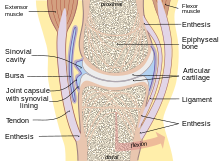Mediopatellar plica

The plica mediopatellaris (medial shelf) is a fold of the inner joint membrane ( joint capsule , synovia ) in the knee joint , which protrudes into the inside of the knee joint. It usually stretches in the inner knee joint compartment from the inside towards the middle of the knee joint and, due to its location, acts like a bowstring. The constant gliding of the arch tendon-like plica over the sensitive and difficult to repair articular cartilage of the inner thigh roller can lead to gradual cartilage damage.
History of origin
The plica mediopatellaris and other plicae in the knee originate from early childhood development ( embryogenesis ). Often the plicae recede in the course of growth. In over 50% of people, however, a plica remains and can then lead to problems.
Symptoms
Plicae rarely cause acute problems. Rather, there are gradual irritation symptoms due to the chronic shearing mechanism of the articular cartilage described above. During the examination, the plica fold over the inner thigh roll can occasionally be felt on the extended knee. When moving the knee through, a snap phenomenon can be triggered at this point.
Diagnosis
With magnetic resonance tomography (nuclear spin, MRT) as a very sensitive imaging method, a plica can be reliably displayed. However, the correct sequences must be used and the examiner must be familiar with the clinical picture. Therefore, the diagnosis of plica syndrome is usually a clinical diagnosis in the hands of an experienced trauma surgeon or orthopedic surgeon, or it is an incidental finding during an arthroscopy for another reason.
therapy
Conservative therapeutic measures such as knee joint injections or anti-inflammatory drugs can only reduce the irritation, but do not change anything in the further presence of the tendon-like folds of the mucous membrane. Therefore, if you have symptoms, you should consider an arthroscopy at an early stage. This operation is usually carried out on an outpatient basis and with few complications. The plica, which is unnecessary for the normally functioning biomechanics of the knee, is removed with special instruments.